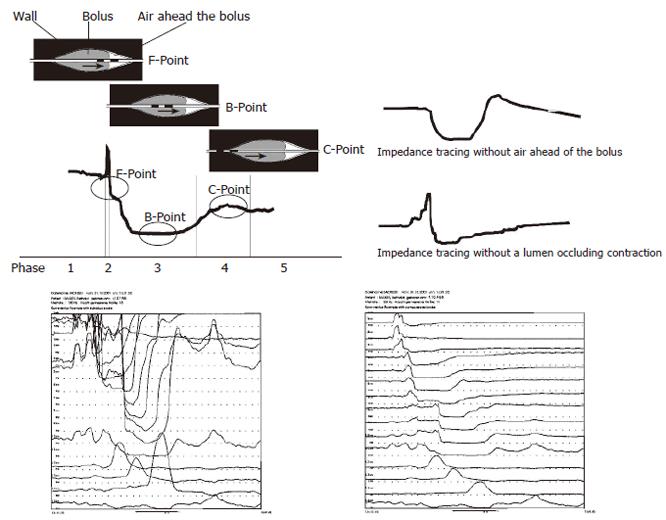Copyright
©2006 Baishideng Publishing Group Co.
World J Gastroenterol. Oct 21, 2006; 12(39): 6266-6273
Published online Oct 21, 2006. doi: 10.3748/wjg.v12.i39.6266
Published online Oct 21, 2006. doi: 10.3748/wjg.v12.i39.6266
Figure 2 Upper panel: Characteristics of the impedance tracing during bolus passage in the esophagus of healthy persons.
The black electrodes indicate a measuring segment. From baseline, the initial sudden impedance increase represents the arrival of ingested air ahead of the bolus. During the rapid impedance fall due to the arrival of the bolus, the bolus head (F-Point) can be determined as the return of impedance closely to baseline. The bolus passage is represented by a further decrease of impedance followed by a plateau phase. During the plateau phase (phase 3) the bolus is located within the measuring segment. The minimum impedance value during this phase is related to the maximum bolus volume located within the segment, which represents the bolus body (B-Point). Subsequently impedance increases due to wall contraction and the bolus is leaving the segment. The maximum value during impedance increase back to baseline is associated with the moment of lumen occlusion (C-Point). Dependent on bolus volumen and bolus viscosity the exact position of the points of interest is variable as indicated by the oval circle. The impedance tracing may be variable as shown at the right side without air ahead of the bolus or without a rapid lumen occluding contraction. Lower panel: For visuallisation of the minimum and maximum impedance an individual scaling (left side) can be used instead of a normal scaling (right side).
- Citation: Nguyen HN, Domingues GRS, Lammert F. Technological insights: Combined impedance manometry for esophageal motility testing-current results and further implications. World J Gastroenterol 2006; 12(39): 6266-6273
- URL: https://www.wjgnet.com/1007-9327/full/v12/i39/6266.htm
- DOI: https://dx.doi.org/10.3748/wjg.v12.i39.6266









